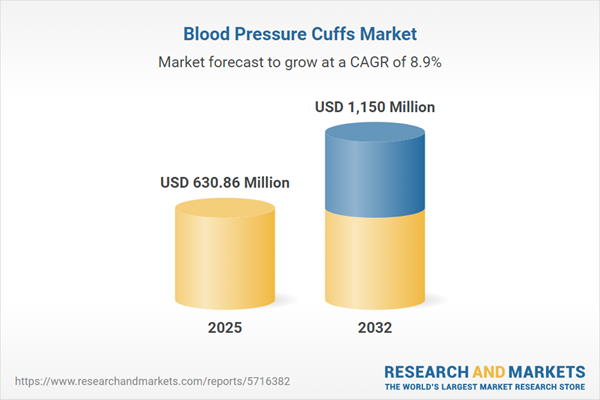Speak directly to the analyst to clarify any post sales queries you may have.
The blood pressure cuffs market is undergoing significant transformation as healthcare organizations seek solutions that align with modern clinical, technological, and supply chain demands. Senior decision-makers are evaluating innovations, compliance priorities, and integration strategies to optimize both procurement and patient care pathways.
Market Snapshot: Blood Pressure Cuffs Market Size and Growth
The blood pressure cuffs market expanded from USD 581.86 million in 2024 to USD 630.86 million in 2025, with projections reaching USD 1.15 billion by 2032 and a compound annual growth rate (CAGR) of 8.92%. Growth is propelled by the adoption of wearable monitoring devices, increased wellness awareness, and enhancements in patient monitoring protocols. The trend toward connected healthcare and the pursuit of workflow optimization are further driving demand, as providers extend care beyond traditional clinical settings to prioritize operational efficiency and patient access.
Scope & Segmentation of the Blood Pressure Cuffs Market
- Product Types: Disposable blood pressure cuffs are designed to address infection control in high-risk environments, while reusable options support cost efficiency and higher patient throughput for facilities managing significant caseloads.
- Measurement Mechanisms: Aneroid and mercury cuffs serve as reliable solutions in settings requiring precision, and oscillometric varieties enable digital and automated monitoring with minimal operator intervention.
- Connectivity Options: Standard models suffice for routine care, while new wireless solutions utilize Bluetooth, cellular, and Wi-Fi to enable integration with electronic health records and boost telemedicine efforts.
- Materials: Common construction materials such as nylon, polyester, or thermoplastic polyurethane (TPU) are selected for durability, comfort, compliance, and sustainability, addressing both patient needs and regulatory expectations.
- Applications: Utilization spans ambulatory monitoring, core clinical diagnostics, fitness tracking, home-based care, perioperative and continuous surveillance, and clinical trial support, reflecting the market’s adaptability.
- End Users: Both individual consumers focusing on health management and institutional buyers—including clinics, ambulatory centers, and hospitals—contribute to diversification and demand.
- Distribution Channels: Pharmacies, direct sourcing by institutions, e-commerce, and digital procurement platforms enhance accessibility, giving buyers more flexibility and control in sourcing strategies.
- Geographies: The market’s footprint includes the Americas, Europe, Middle East and Africa, and Asia-Pacific. Notably, regions such as China, India, Japan, Australia, South Korea, Indonesia, Thailand, Malaysia, Singapore, and Taiwan have unique regulatory and consumer preferences shaping localized demand profiles.
- Leading Companies: Competitive participants range from established brands like Omron Healthcare, Koninklijke Philips, A&D Company, and Cardinal Health, to specialized providers including B. Braun Melsungen AG, Beurer GmbH, General Electric Company, SunTech Medical, and Withings by Nokia Corporation among others.
Key Takeaways for Senior Decision-Makers
- Decentralized care delivery is accelerating, requiring organizations to adapt procurement and deployment models for outpatient and at-home monitoring technologies.
- Wireless and automated calibration technologies now facilitate improved usability and compliance across care settings, simplifying caregiver training and broadening user uptake.
- Regulatory expectations around data interoperability and cybersecurity are increasing, making technology choices that support scalability and robust cyber protection vital.
- Acute care infection control remains a central consideration, while cost-conscious facilities may prioritize durable, reusable devices to align with operational budgets.
- Strategic partnerships with digital health technology and regional suppliers enable faster adaptation to market shifts and regulatory developments, supporting expansion and risk mitigation.
Tariff Impact on the Blood Pressure Cuffs Market
Recent tariff changes in the United States have led manufacturers to reevaluate production locations and supplier strategies. Many firms are relocating manufacturing closer to core geographic markets, renegotiating supplier agreements, and expanding supplier networks. These responses help organizations maintain operational resilience, strengthen domestic production, and remain agile amid evolving global procurement and regulatory conditions.
Methodology & Data Sources
This analysis draws from direct interviews with industry executives, clinical leaders, and supply chain specialists, as well as extensive secondary research from peer-reviewed publications, regulatory bodies, and recognized industry sources. Findings have been cross-verified for accuracy and senior executive relevance.
Why This Report Matters: Actionable Insights for Healthcare Leaders
- Healthcare decision-makers can refine sourcing and investment strategies by understanding shifts in user expectations and emerging technology adoption.
- The report provides guidance on navigating evolving regulation and advances in remote care, helping leaders bolster strategic planning and drive sustainable growth.
- By addressing current supply chain and regulatory challenges, organizations can better respond to industry changes and policy updates with agility and confidence.
Conclusion
The blood pressure cuffs market is advancing with digital integration and updated regulatory approaches. Organizations prioritizing connectivity, sustainability, and adaptable product portfolios will be positioned to meet evolving healthcare and operational requirements.
Additional Product Information:
- Purchase of this report includes 1 year online access with quarterly updates.
- This report can be updated on request. Please contact our Customer Experience team using the Ask a Question widget on our website.
Table of Contents
3. Executive Summary
4. Market Overview
7. Cumulative Impact of Artificial Intelligence 2025
List of Figures
Samples

LOADING...
Companies Mentioned
The key companies profiled in this Blood Pressure Cuffs market report include:- Omron Healthcare, Inc.
- Koninklijke Philips N.V.
- A&D Company, Limited
- American Diagnostic Corporation
- B. Braun Melsungen AG
- Beurer GmbH
- BPL Medical Technologies
- Cardinal Health, Inc.
- CONTEC Medical Systems Co., Ltd
- Elanor Surgicals
- General Electric Company
- Hill-Rom Holdings, Inc.
- Kaz Inc. by Troy Company
- Medline Industries, Inc.
- Microlife Corporation
- Midmark Corporation
- Narang Medical Limited
- Nihon Kohden Corporation
- Rossmax International Ltd.
- Spacelabs Healthcare Inc.
- Spengler SAS
- SunTech Medical, Inc. by Halma plc
- Technicuff Corporation
- Withings by Nokia Corporation
Table Information
| Report Attribute | Details |
|---|---|
| No. of Pages | 198 |
| Published | October 2025 |
| Forecast Period | 2025 - 2032 |
| Estimated Market Value ( USD | $ 630.86 Million |
| Forecasted Market Value ( USD | $ 1150 Million |
| Compound Annual Growth Rate | 8.9% |
| Regions Covered | Global |
| No. of Companies Mentioned | 25 |









